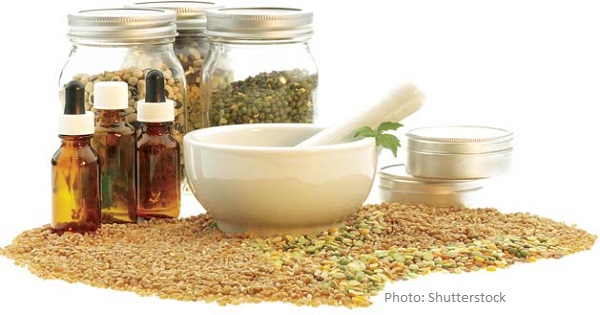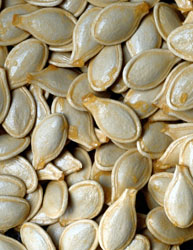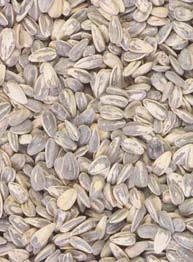|

The Seeds of Health
by Wendy Priesnitz
Birds might have small brains, but they are smart enough to know the value of eating raw seeds. Seeds store the potential for life within their tiny shells, making them a highly concentrated form of healthy food for birds and for humans. Plants fill each genetic packet with vitamins, minerals, proteins, essential oils and dormant enzymes.
The nutrients in seeds are quite fragile. So if they have been removed from their shells, they need to be kept in the refrigerator. Eat only very fresh seeds where the fragile oils have not been compromised by heat, light or air. Some people find that sprouted seeds are more easily digested than the raw seed, perhaps because their nutrients are somewhat less concentrated and their enzymes more accessible.
 Pumpkin Seeds Pumpkin Seeds
Don't toss out all those seeds that are left over from your Halloween pumpkin! Subtly sweet and nutty with a chewy texture, the roasted seeds are a nutritious and flavorful treat. Pumpkin seeds are available year around, however, they are the freshest in the fall when pumpkins are in season.
Pumpkin seeds, also known as pepitas, are flat, dark green seeds. Most are encased in a yellow-white husk, although some varieties of pumpkins produce seeds without shells. Like cantaloupe, cucumber, and squash, pumpkins and pumpkin seeds belong to the gourd or Cucurbitaceae family.
Pumpkin seeds contain a wide range of nutrients. They are a very good source of the minerals magnesium, manganese and phosphorous, and a good source of iron, copper, protein, monounsaturated fat and zinc. Sixty-eight grams (two ounces) of pumpkin seeds provides 46 percent of the recommended daily value for magnesium, almost 30 percent of the recommended amount of iron, 52 percent of manganese, 24 percent copper, 17 percent of protein, almost 20 percent of monounsaturated fat, and 17 percent of zinc.
Zinc is a trace mineral, in which many people are deficient. In addition to helping balance blood sugar, stabilizing the metabolic rate and protecting the immune system, zinc has been found to protect bone density in both men and women. A study of 396 men ranging in age from 45 to 92 years of age that was published in 2004 in the American Journal of Clinical Nutrition found a correlation between low dietary intake of zinc, low blood levels of the mineral and osteoporosis at the hip and spine.
Another recently publicized benefit from eating pumpkin seeds involved the prostate. Apparently, pumpkin seeds contain a chemical substance called cucurbitacin that can prevent the body from converting testosterone into a more potent form called dihydrotestosterone, which contributes to prostate enlargement.
According to the non-profit George Mateljan Foundation, which promotes healthy eating, pumpkin seeds are also of benefit to those suffering from arthritis. They cite animal studies that have favorably compared the addition of pumpkin seeds to the diet with use of the non-steroidal anti-inflammatory drug indomethacin in reducing inflammatory symptoms. Plus, pumpkin seeds avoid the side effects of drug therapy, which include increasing the level of damaged fats in the linings of the joints.
Like sunflower seeds, pumpkin seeds were an important part of the dietary and medicinal lives of North America’s early residents. And like sunflowers, the cultivation of pumpkins spread throughout the world when the European explorers took home many of the agricultural treasures of the New World. While pumpkin seeds are featured in the recipes of many cultures, they are a special hallmark of traditional Mexican cuisine.
Pumpkin seeds should be stored in an airtight container in the refrigerator. While they may stay edible for several months, they seem to lose their peak freshness after about one to two months.
 Sunflower Seeds Sunflower Seeds
Sunflower seeds should be at or near the top of anyone’s edible seed shopping list. In addition to being the best whole-food source of Vitamin E (76 percent of the recommended daily allowance), they are high in protein and naturally low in carbohydrates. In fact, the only major nutrient they don’t supply is vitamin D.
Every 100-gram (3.5- ounce) serving of sunflower seeds contains 30 grams of unsaturated fats, 30 milligrams of linoleic acid (which reduces cholesterol deposits in the arteries and veins) and 7 milligrams of iron (compared to 2½ milligrams in the same serving of beef). Flour made from ground sunflower seeds is considered second only to brewers’ yeast as the richest source of iron. Sunflower seeds also deliver phytochemicals like phenolic acids and lignans, which may help prevent heart disease and cancer.
Sunflower seeds are also rich in B vitamins (especially thiamin and niacin), potassium (which helps reduce sodium in the body) and in magnesium and phosphorus (which help the body absorb calcium). The calcium to phosphorus ratio makes the calcium readily available for the building of strong bones. A mere 28 grams (one ounce) of sunflower seeds also provides about one-quarter of our daily need for both selenium and copper. Selenium is an antioxidant that has been shown to work with vitamin E to protect cells from damage. Copper may also help prevent oxidative stress, which has been associated with heart disease.
Since sunflower seeds are high in unsaturated fat, they are an especially important addition to the menu for anyone on a high-protein, low-carb diet. In the Nurses’ Health Study, Harvard researchers found that replacing 80 calories of carbohydrates with 80 calories of either polyunsaturated or monounsaturated fats lowered risk for heart disease by about 30 to 40 percent. Sunflower seeds provide only four grams of carbohydrate per 28-gram (one-ounce) serving, two grams of which are fiber.
With all this great nutritional value, it is fortunate that sunflower seeds are not a commonly allergenic food. When purchasing unshelled sunflower seeds, make sure that the shells are not broken or dirty. They should be firm and not have a limp texture. When purchasing shelled seeds, avoid those that are yellow, as they have probably gone rancid. In addition, if you are purchasing sunflower seeds from a bulk bin, smell them to ensure that they are still fresh and not rancid. Since sunflower seeds have a high fat content and are prone to rancidity, it is best to store them in an airtight container in the refrigerator or freezer.
Purchasing really fresh sunflower seeds shouldn’t be too difficult, since they are grown widely. While they are thought to have originated in Mexico and Peru, they are one of the first plants to ever be cultivated in the United States.
They have been used for more than 5,000 years by North America’s indigenous people, who not only used the seeds as a food and an oil source, but also used the flowers, roots and stems for varied purposes including a dye pigment. The Spanish explorers brought sunflowers back to Europe, and after being first grown in Spain, they were subsequently introduced to other neighboring countries.
Flax Seeds
The reddish brown color of flax seeds mirrors their warm, earthy flavor. Slightly larger than sesame seeds and equipped with a shiny, hard shell, these tiny packets are a major source of omega-3 fatty acids, especially alpha-linolenic acid (ALA), which helps promote heart health and has been the subject of over a thousand research projects investigating its effects on numerous health conditions.
Omega-3 fats are used by the body to produce Series 1 and 3 prostaglandins, which are anti-inflammatory hormone-like molecules, in contrast to the Series 2 prostaglandins, which are pro-inflammatory molecules produced from other fats, notably the Omega-6 fats. Omega-6 fats are found in high amounts in animal fats, margarine and many vegetable oils. Omega-3 fats can help reduce the inflammation that is a significant factor in conditions such as asthma, osteoarthritis, rheumatoid arthritis and migraine headaches.
Omega-3 fats also produce substances that reduce the formation of blood clots, which can reduce the risk of heart attack and stroke in patients with atherosclerosis or diabetic heart disease.
They are also needed to produce flexible cell membranes, which are the walls surrounding brain cells or neurons. The membranes allow in needed nutrients while promoting the elimination of wastes. Electrical signals traveling through the brain also get passed from one brain cell to the next through these cell membranes. They consist almost entirely of fats, with about 20 percent of them being essential fatty acids like Omega-3s. While important for everyone’s health and optimum functioning, flexible cell membranes are critical for people with diabetes since flexible cell membranes are much better able to respond to insulin and to absorb glucose than the stiff membranes that result when the diet is high in saturated and/or hydrogenated (trans-) fats.
Good health requires the right ratio of Omega-3 fatty acids to Omega-6 fatty acids in the diet. The ideal ratio is around 1:2. The average North American diet is more around 1:20 to 1:50, with way too much Omega-6 and not enough Omega-3. The ratio present in flaxseed oil is about 4:1. However regular use of flax seed oil can cause Omega-6 deficiency symptoms. So many people blend flaxseed oil with other oils that contain more Omega-6, in order to get the right balance. In the colon, Omega-3 fats help protect cells from cancer-causing toxins and free radicals, leading to a reduced risk for colon cancer.
Also helpful to colon health is the fiber that is present in flax seed. Fiber can lower cholesterol levels in people with atherosclerosis and diabetic heart disease, reduce the exposure of colon cells to cancer-causing chemicals, relieve the constipation or diarrhea of irritable bowel syndrome sufferers and help stabilize blood sugar levels in diabetic patients.
Magnesium is another nutrient that flax has in good supply. It helps to reduce the severity of asthma, lowers high blood pressure, reduces the risk of heart attack and generally promotes relaxation
Flax seed is also rich in lignans and contains 100 times more than the next best source, which is wheat bran. Lignans are special compounds also found in other seeds, grains, and legumes that are converted by beneficial gut flora into two hormone-like substances called enterolactone and enterodiol. By reducing bio-available estrogen, these phytoestrogens lessen the risk for breast cancer. In animal studies conducted to evaluate lignans’ beneficial effect, supplementing a high-fat diet with flaxseed flour reduced early markers for mammary cancer in rats by more than 55 percent. Lignans can also promote normal ovulation and extend the second, progesterone-dominant half of the menstrual cycle, helping to restore hormonal balance in pre-menopausal women.
Flax has been known since the Stone Age. One of the first records of the culinary use of flax seeds is from ancient Greece, where their health benefits were well known. The early colonists from Europe introduced the flax plant to the United States and then to Canada, which is now the world’s major producer of flax.
Flax seeds can be purchased either whole or already ground. Although ground flax seeds may be more convenient, whole flax seeds have a longer shelf life. However, whole seeds cannot be digested and should be ground or pressed before consumption. Once flax seeds are ground, they are prone to oxidation and spoilage, so buy fresh or grind your own, and keep them refrigerated. Flaxseed oil is especially perishable and should be purchased in opaque bottles that have been kept refrigerated. Flaxseed oil should have a sweet nutty flavor, so check for rancidity before use.
Hemp Seeds
Hemp seed is a nutritionist’s dream. In fact, it is considered by many dietary experts to be one of the most nutritious food sources on the planet. Shelled hemp seed contains 33 percent pure digestible protein and is rich in iron and vitamin E as well as an ideal balance of Omega-3 and Omega-6 fatty acids. It also has two special EFAs – gamma-linolenic acid (GLA), believed to relieve menstrual breast pain, and stearidonic acid (SDA), a highly effective Omega-3 rarely found in plant oils.
A recent report funded by the Canadian government states that hemp protein is comprised of 66 percent high-quality protein, and that hemp seed contains the highest percentage of this protein of any plant source. Hemp also contains three times the vitamin E of flax. Unlike soy, it is not genetically modified, and it doesn’t contain the anti-nutritional qualities commonly found in soy.
Hemp also contains abundant amounts of some important trace minerals, B vitamins and fiber. A ten-gram serving (approximately one tablespoon) has six percent of the recommended daily value of iron, 17 percent of the recommended amount of magnesium and 50 percent of manganese.
Like the other seed oils described in this article, hemp oil may help alleviate the symptoms of inflammatory diseases such as rheumatoid arthritis, osteoporosis, Crohn’s disease and ulcerative colitis. Hemp oil also contains GLA, the active component in Evening Primrose Oil, which may be successful in the treatment of eczema, PMT, menopause and arthritis.
Hemp seed has been consumed for centuries. Indeed, it has sustained whole populations during times of famine. Hemp was cultivated in China more than 6,000 years ago, from a wild plant that grew in central Asia. The Chinese recognized hemp’s amazing nutritional value, and used it as a food source long before soy foods. About a thousand years ago, hemp traveled to Europe, where peasants used the plant in several ways, both food- and non-food-related. One of the most popular uses was the making of hemp butter by grinding the tasty seeds. However, there is no need to grind hemp seed; simply use as is, or toast to enhance its nutty flavor. Refrigerate hemp products after they’re opened, and use within eight weeks.
Many seeds are nutritional powerhouses. Udo Erasmus, nutritional writer and proponent of healthy fats like flax seed oil, calls them “Nature’s ancient superfood”.
Wendy Priesnitz is Natural Life Magazine's editor, a book author and journalist with over 40 years of experience.
|

